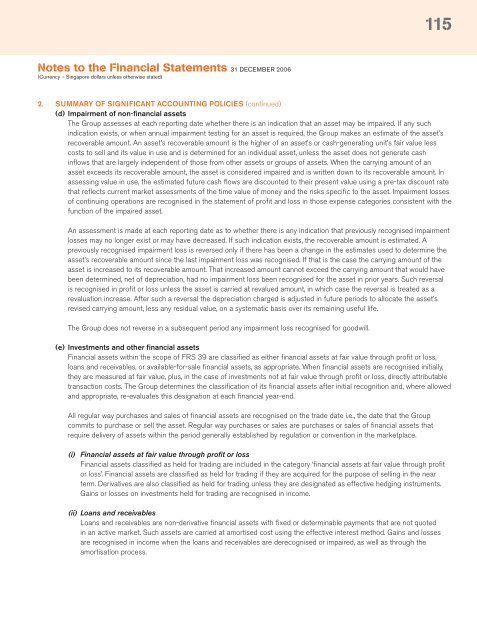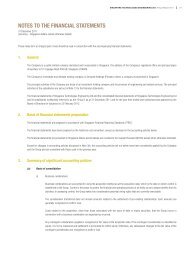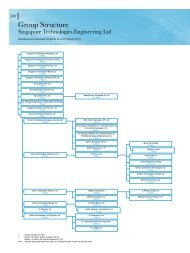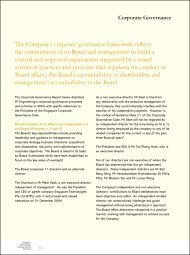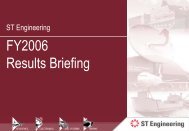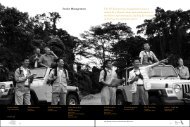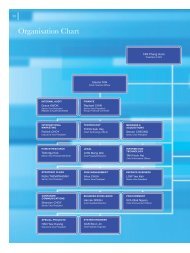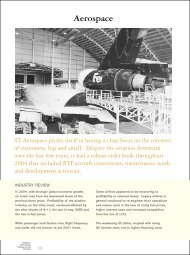Full Annual Report 2006 - Singapore Technologies Engineering
Full Annual Report 2006 - Singapore Technologies Engineering
Full Annual Report 2006 - Singapore Technologies Engineering
Create successful ePaper yourself
Turn your PDF publications into a flip-book with our unique Google optimized e-Paper software.
115<br />
Notes to the Financial Statements 31 DECEMBER <strong>2006</strong><br />
(Currency – <strong>Singapore</strong> dollars unless otherwise stated)<br />
2. SUMMARY OF SIGNIFICANT ACCOUNTING POLICIES (continued)<br />
(d) Impairment of non-financial assets<br />
The Group assesses at each reporting date whether there is an indication that an asset may be impaired. If any such<br />
indication exists, or when annual impairment testing for an asset is required, the Group makes an estimate of the asset’s<br />
recoverable amount. An asset’s recoverable amount is the higher of an asset’s or cash-generating unit’s fair value less<br />
costs to sell and its value in use and is determined for an individual asset, unless the asset does not generate cash<br />
inflows that are largely independent of those from other assets or groups of assets. When the carrying amount of an<br />
asset exceeds its recoverable amount, the asset is considered impaired and is written down to its recoverable amount. In<br />
assessing value in use, the estimated future cash flows are discounted to their present value using a pre-tax discount rate<br />
that reflects current market assessments of the time value of money and the risks specific to the asset. Impairment losses<br />
of continuing operations are recognised in the statement of profit and loss in those expense categories consistent with the<br />
function of the impaired asset.<br />
An assessment is made at each reporting date as to whether there is any indication that previously recognised impairment<br />
losses may no longer exist or may have decreased. If such indication exists, the recoverable amount is estimated. A<br />
previously recognised impairment loss is reversed only if there has been a change in the estimates used to determine the<br />
asset’s recoverable amount since the last impairment loss was recognised. If that is the case the carrying amount of the<br />
asset is increased to its recoverable amount. That increased amount cannot exceed the carrying amount that would have<br />
been determined, net of depreciation, had no impairment loss been recognised for the asset in prior years. Such reversal<br />
is recognised in profit or loss unless the asset is carried at revalued amount, in which case the reversal is treated as a<br />
revaluation increase. After such a reversal the depreciation charged is adjusted in future periods to allocate the asset’s<br />
revised carrying amount, less any residual value, on a systematic basis over its remaining useful life.<br />
The Group does not reverse in a subsequent period any impairment loss recognised for goodwill.<br />
(e) Investments and other financial assets<br />
Financial assets within the scope of FRS 39 are classified as either financial assets at fair value through profit or loss,<br />
loans and receivables, or available-for-sale financial assets, as appropriate. When financial assets are recognised initially,<br />
they are measured at fair value, plus, in the case of investments not at fair value through profit or loss, directly attributable<br />
transaction costs. The Group determines the classification of its financial assets after initial recognition and, where allowed<br />
and appropriate, re-evaluates this designation at each financial year-end.<br />
All regular way purchases and sales of financial assets are recognised on the trade date i.e., the date that the Group<br />
commits to purchase or sell the asset. Regular way purchases or sales are purchases or sales of financial assets that<br />
require delivery of assets within the period generally established by regulation or convention in the marketplace.<br />
(i) Financial assets at fair value through profit or loss<br />
Financial assets classified as held for trading are included in the category ‘financial assets at fair value through profit<br />
or loss’. Financial assets are classified as held for trading if they are acquired for the purpose of selling in the near<br />
term. Derivatives are also classified as held for trading unless they are designated as effective hedging instruments.<br />
Gains or losses on investments held for trading are recognised in income.<br />
(ii) Loans and receivables<br />
Loans and receivables are non-derivative financial assets with fixed or determinable payments that are not quoted<br />
in an active market. Such assets are carried at amortised cost using the effective interest method. Gains and losses<br />
are recognised in income when the loans and receivables are derecognised or impaired, as well as through the<br />
amortisation process.


